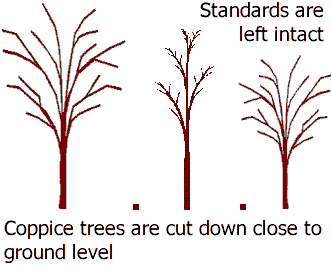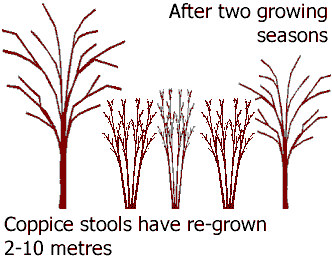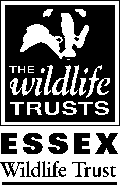During the last fifty years, however, mankind developed fibre-glass, aluminium and plastic, and we keep ourselves warm with natural gas and electricity. We no longer need timber and forest products to the same extent and, without a market, the practice of coppicing was abandoned. Since World War Two, Pound Wood has been used largely for recreation and dog-walking.
This has been a disaster for dormice and badgers, for wrens and woodpeckers, for frogs and newts, for wildflowers and butterflies, and even for trees. Yes, woodland creatures are hooked on the coppice system created by man, and without it many will become extinct. Indeed some quite probably have, locally.
So the management of Pound Wood has been resumed by the Essex Wildlife Trust, with the help of the government’s Forest Authority, to restore a rotation of coppice. An average of just over one acre a year (75 x 75 metres) will be cleared, and the regrowth monitored. It is possible that some replanting of sparser areas will be necessary but natural regeneration by seedlings will be encouraged.
The Trust has also been monitoring the populations of the flora (plants) and fauna (animals) that live in the wood, and the Trust is confident that the management systems now reintroduced will increase the diversity of creatures able to make Pound Wood their home.
The Trust is also managing the wood so that people can enjoy walking here, and horseriders are allowed to use certain paths. The area is being protected against rubbish dumping, motor cycling and squatters. The Trust is making the paths safe and hopes to create ponds and muddy areas for the wild plants and animals which need these conditions and is keeping quite a large area of windblown trees in a state of chaos to protect the wildlife from the attentions of people and their dogs. The Trust is managing the wood for children too, so that they can learn about wildlife and enjoy the thrill of exploring a wildspace.
Since the Essex Wildlife Trust purchased Pound Wood in 1993, the management has been to restore the traditional practice of Coppicing. This was the practice in many such woods over the past centuries. As a consequence of this practice, a rich and diverse flora and fauna developed. This is largely because of the diversity of habitats produced by the traditional coppice-with-standards practice.

Coppicing comprises the cutting down of tree stems close to ground level, the closer the better. In Pound Wood, most coppiced trees are Hornbeam or Chestnut. The first time a tree is cut, in winter, the trunk is typically 10–20cm in diameter.
When a more mature coppice stool is cut, there may be many stems, and trimming to ground level is more difficult. However, the coppicer should aim to trim the stump with an incline from the centre to the outside, so that water is shed from the stumps. In coppice-with-standards, several trees are typically left uncut. In Pound Wood, these are usually Oaks, but could be Ash (or Beech in other woods)

The spring following coppicing, the buds within the cut stump will burst and many shoots will be produced. These will typically grow a metre or so in the first season, and the same again or more in the next season.
Eventually, after ten years or so, these shoots will have reached up, branched and formed a canopy.
At this time (or later) the stems, which may now be 10–20cm in diameter, can be coppiced again and the cycle repeated.
For information about the various copes in Pound Wood and how they have been managed over the years, see the Coupes page.
